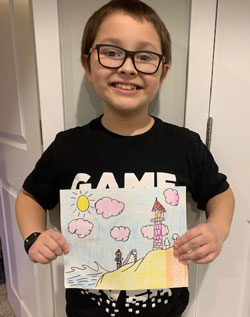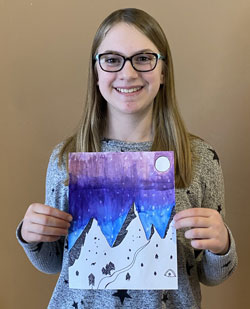Comstock Park — Fifth-grader Casey Sikes really enjoyed his art class last semester. He learned about the shading technique in drawing, something he had never really thought about before.
“Basically, with every new thing we would make, it would inspire me,” said Casey. He especially enjoyed drawing a cityscape showing perspective, where objects farther away appear smaller and objects closer to the viewer look bigger.
“It was the first time I did a project like that,” Casey said.

This drawing by Casey appeared as part of Pine Island Elementary School’s virtual art show. In a typical year, teacher Macy Austin holds an art showcase at the end of the year. Because of the pandemic this year, the show pivoted to a virtual showcase.
Austin took photos of each piece and students wrote about their work to explain why they chose that piece. Austin then uploaded each piece to Google Slides to become part of the show.
The virtual art show was promoted on the schools’ Facebook pages and students and families were able to view from home.
Third-grader Lukas Muller selected a lighthouse drawing as his favorite art project and entry in the showcase. Like Casey, he also enjoyed the shading lesson.
Both Lukas and fifth-grader Skylar DeWild said Austin is good at giving instruction about how to draw.
“She is also very encouraging,” Skylar said of Austin.
For her entry, Skylar chose a mountain drawing she made using a shadowing technique. Austin demonstrated how to shadow and students added their own detail.
“We chose what color we wanted to use and we blended them,” said Skylar, who chose both purple and pink and discovered she was good at blending colors.

Unique Ideas, Unique Outcomes
Austin teaches art at both Pine Island and Stoney Creek elementary schools. Most art classes have been taught in person this year, although she started the year teaching from a cart before just recently switching back to a classroom.
Most of Austin’s elementary art curriculum involves lines, shapes, colors, value, texture and space. She tries to create projects that allow students to bring in their own creativity and ideas.
A new project where students learned about weaving materials and the history of weaving proved to be popular with her third-graders. Austin said weaving gives students an opportunity to explore different ways to create art, which can be especially good for those who might not love to draw or paint.
For the weaving project, students painted a paper plate with tempera paint in the style of Russian artist Wassily Kandinsky’s piece, “Color Study: Squares with Concentric Circles,” and then did a weaving over the painting.
Many of Austin’s students chose their weaving project as their entry in the virtual showcase.
“The weaving project was really popular because it incorporated multiple mediums and materials we don’t get to use all of the time,” she said.
Another third-grade art lesson, this one about Michigan and natural habitats, inspired a lighthouse project.
“We talked about the Great Lakes and why our state has so many lighthouses, and then designed our own,” Austin said.

Building an Art Foundation
Austin believes it is important to expose elementary students to a wide variety of materials, mediums and artists so they can build a foundation as they progress to middle school and high school. This means she doesn’t just teach color and simple drawing. Instead, her students learn everything from drawing in perspective to watercolor and oils techniques.
“I love giving students a break from their busy day where they can express themselves, try new things and show off their creativity using materials they don’t always have access to,” Austin said.
To help measure the progress of her art students, Austin sets individual goals as well as class goals for projects, which are discussed in class. She leaves class goals vague so students can achieve success in numerous ways. During the middle and end of a project, students will reflect on whether or not they achieved the goal. They also set their own goals for their projects.
“Sometimes (the goals) are to include more elements of art, and sometimes it may be as simple as trying to complete a certain portion of their project in the class time,” said Austin. “The best part about art is that every piece is unique and there is not one correct answer for any project.”
CONNECT









